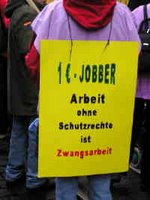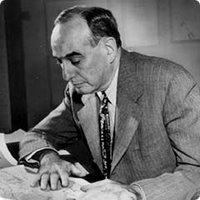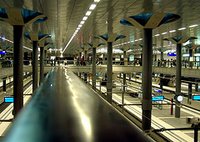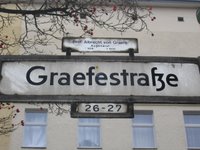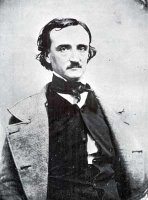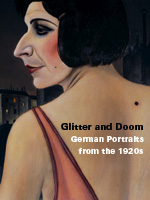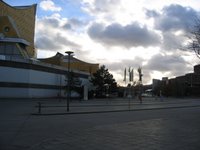 Most Embarrassing or Most Effective?
Most Embarrassing or Most Effective?January 27th marked the 62nd anniversary of the liberation of Auschwitz, a day officially commemorated in Germany with memorial ceremonies, educational programs, and official utterances from high-profile politicians. Yet Lea Rosh, a publicist who rose to fame as the promoter of Berlin’s Memorial to the Murdered Jews of Europe, conducted a protest. She organized the protest in Berlin’s main train station Hauptbahnhof to demonstrate her dissatisfaction with Deutsche Bahn’s new plan for a memorial to the deportation of Germany’s Jews. She wasn’t protesting the company’s initiative, of which she approved, nor the location of the commemoration, which the firm has agreed to place in train stations right alongside contemporary travelers. Rather, Rosh was upset with Deutsche Bahn for taking too long. According to her, the announced “conception phase” of one year to review plans for the memorial and decide upon its design ought to be shortened.
 Could it be that Rosh doesn’t believe that the Bahn could possibly need a whole year to develop a working concept? This explanation is unlikely, given that the monument Rosh brought to existence, commonly called the Holocaust Memorial, took seventeen years from conception to completion. Rosh witnessed multiple design competitions, presided over public forums about whether the plans should go forward, and campaigned no-holds-barred against occasionally resistant politicians to bring her pet project to light. She is intimately acquainted with the delicate and slow politics of commemoration, as well as with the belabored examination of every little detail of designs. So why is Rosh so set on telling the Bahn to speed things up?
Could it be that Rosh doesn’t believe that the Bahn could possibly need a whole year to develop a working concept? This explanation is unlikely, given that the monument Rosh brought to existence, commonly called the Holocaust Memorial, took seventeen years from conception to completion. Rosh witnessed multiple design competitions, presided over public forums about whether the plans should go forward, and campaigned no-holds-barred against occasionally resistant politicians to bring her pet project to light. She is intimately acquainted with the delicate and slow politics of commemoration, as well as with the belabored examination of every little detail of designs. So why is Rosh so set on telling the Bahn to speed things up?To frame this question properly, one needs to know a bit more about the woman. Her initial career as a West German journalist was quickly superseded by her role as memorial-campaigner after she first proposed the idea during a panel discussion in Berlin in summer 1988. To further her cause, she had founded the citizens’ group “Perspective Berlin,” of which she made herself chairwoman, which later became the Association for the Promotion of the Establishment of a Memorial to the Murdered Jews of Europe [Förderkreis zur Errichtung eines Denkmals für die ermordeten Juden Europas]. It sounds earnest enough in the telling, yet the crusader-like stance Rosh adopted repelled many who came to see her as a woman in search of a pedestal from which to preach. Some accused her of changing her name from the original “Edith” to “Lea” to sound more Jewish and called her self-styled role as “fighter” for the memory of murdered Jews self-righteous, asking how she could claim to speak for the victims. Her typical response was, “if not me, then who?” Yet her public image remained in question and the popular biweekly magazine Tip’s named her #1 of the “The 100 Most Embarrassing Berliners” in its 2004 annual survey.

Rosh’s behavior at the Memorial’s 2005 dedication ceremony also cast doubts as to how earnest she was in her desire to respect the dead, re-raising the specter of an attention-loving gadfly. Her speech concluded with the suggestion to bury an original cloth star of David and a molar she had found at the Belzec concentration camp in Poland within one of the concrete stele that compose the monument. Rosh had not previously announced her intent and since the monument’s building process revolved around planning, consultation, and group consensus, her surprise gesture was received as self-important and disrespectful.
It also offended the Jewish community for its taboo stance towards Jewish law. Albert Meyer, Chairman of Berlin’s Jewish Community [Vorsitzender der Jüdische Gemeinde], furiously responded that Rosh’s gesture violated the religious burial order that Jewish corpses and parts thereof only be buried in Jewish cemeteries. Rosh responded that her wish was in accordance with Jewish law and enlisted Rabbi Yitzhak Ehrenberg to clarify that the law only applied to large body parts, and that single teeth could be exempt.[1] This could not deliver her from the rage of Belzec’s administration, who scolded that it was “strongly forbidden” to take “souvenirs” away from a visit to the camp.[2] The question remains whether such an astoundingly obtuse blunder, which managed to somehow offend everyone, was just a clumsy mistake, or evidence of Rosh’s privileging of her own self-styled crusader role respect for those she claims to represent.
 Other evidence that Rosh puts controversy and public attention before the emotions of the Jewish community is her creation of offensive controversy in the form of posters proclaiming “The Holocaust never happened.” The posters, created during debates about the memorial and intended to raise her campaign’s profile by demonstrating the offensive nature of Holocaust denial, worked a little too well, offending survivors and Jewish groups. Rosh later removed the posters, but her defiant, entitled stance has remained a constant throughout her public engagement, as evidenced in this latest incident. When asked whether she had a right to protest on privately-owned land, that is, Deutsche Bahn’s train station, she responded with the flip assertion, “It would be unwise to throw us out.”
Other evidence that Rosh puts controversy and public attention before the emotions of the Jewish community is her creation of offensive controversy in the form of posters proclaiming “The Holocaust never happened.” The posters, created during debates about the memorial and intended to raise her campaign’s profile by demonstrating the offensive nature of Holocaust denial, worked a little too well, offending survivors and Jewish groups. Rosh later removed the posters, but her defiant, entitled stance has remained a constant throughout her public engagement, as evidenced in this latest incident. When asked whether she had a right to protest on privately-owned land, that is, Deutsche Bahn’s train station, she responded with the flip assertion, “It would be unwise to throw us out.”So is Rosh truly a righteous crusader championing a cause many would rather just be done with? Or is she a muckraker in search of acclaim, clinging to an issue that turns heads? Does she aim to churn up controversy or remembrance? Perhaps it doesn’t matter. The more engrossingly obnoxious Rosh’s public persona becomes, the more people read about her and pay attention to what she’s doing. As a consequence, her efforts at commemoration receive much press, and, as with the Holocaust Memorial, are one day actualized. Perhaps the realm of memory needs more people like Rosh, who rather than acting polite and appropriate, embarrass and annoy everyone into listening.
[1] Quoted in Claudia Keller, “Empoerung ueber Lea Rosh” 12 May 2005, Der Tagesspiegel. 14
[2] “Stelenspringer.” Frankfurter Allgemeine Zeitung, 14 May 2005
Top Rosh image courtesy http://www.morgenpost.de/content/2005/05/14/berlin/753649.html?redirID

